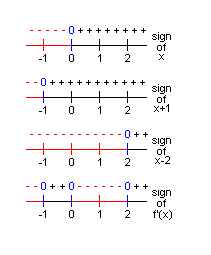|
The First Derivative: Maxima and Minima
Consider the function
on the interval [-2,3]. We cannot find regions on which f is
increasing or decreasing, relative maxima or minima, or the absolute
maximum or minimum value of f on [-2,3] by inspection. Graphing
by hand is tedious and imprecise. Even the use of a graphing program
will only give us an approximation for the locations and values of
maxima and minima. We can use the first derivative of f, however,
to find all these things quickly and easily.
Increasing or Decreasing?
Let f be continuous on an interval I and differentiable on the
interior of I. Then, by the Mean Value Theorem:
- If f ′(x) > 0 for all x ∈ (interior of I), then f is increasing
on I.
- If f ′(x) < 0 for all x ∈ (interior of I), then f is decreasing
on I.

Example
The function f(x) = 3x4-4x3-12x2+3 has first derivative
Thus, f(x) is increasing on [-1,0] U [2, ∞) and decreasing
on (-∞,-1] U [0,2].
Relative Maxima and Minima
Relative extrema of f occur at critical points of f, values
x0 for which either f ′(x0) = 0 or f ′(x0) is undefined.
First Derivative Test
Suppose f is continuous at a critical point x0.
- If f ′(x) > 0 on an open interval extending left from x0 and
f ′(x) < 0 on an open interval extending right from x0, then f
has a relative maximum at x0.
- If f ′(x) < 0 on an open interval extending left from x0 and
f ′(x) > 0 on an open interval extending right from x0, then f
has a relative minimum at x0.
- If f ′(x) has the same sign on both an open interval extending
left from x0 and an open interval extending right from x0, then
f does not have a relative extremum at x0.
In summary, relative extrema occur where f ′(x) changes sign.
Example
 Our function f(x) = 3x4-4x3-12x2+3 is differentiable everywhere
on [-2,3], with f ′(x) = 0 for x = -1,0,2. These are the three
critical points of f on [-2,3]. By the First Derivative Test, f
has a relative maximum at x = 0 and relative minima at x = -1 and
x = 2.
Our function f(x) = 3x4-4x3-12x2+3 is differentiable everywhere
on [-2,3], with f ′(x) = 0 for x = -1,0,2. These are the three
critical points of f on [-2,3]. By the First Derivative Test, f
has a relative maximum at x = 0 and relative minima at x = -1 and
x = 2.
Absolute Maxima and Minima
- If f has an extreme value on an open interval, then
the extreme value occurs at a critical point of f.
- If f has an extreme value on a closed interval, then
the extreme value occurs either at a critical point or at an endpoint.
According to the Extreme Value Theorem, if a function is
continuous on a closed interval, then it achieves both an absolute
maximum and an absolute minimum on the interval.
Example
Since f(x) = 3x4-4x3-12x2+3 is continuous on [-2,3], f must
have an absolute maximum and an absolute minimum on [-2,3]. We
simply need to check the value of f at the critical points
x = -1,0,2 and at the endpoints x = -2 and x = 3:
Thus, on [-2,3], f(x) achieves a maximum value of 35 at x = -2 and
a minimum value of -29 at x = 2.
We have discovered a lot about the shape of f(x) = 3x4-4x3-12x2+3
without ever graphing it! Now take a look at the graph and verify
each of our conclusions.
Graph it!
Key Concepts [index]
- Increasing or Decreasing?
Let f be continuous on an interval I and differentiable on the
interior of I. If f ′(x) > 0 for all x ∈ I, then f is
increasing on I. If f ′(x) < 0 for all x ∈ I, then f is
decreasing on I.
- Relative Maxima and Minima
By the First Derivative Test, relative extrema occur where f ′(x)
changes sign.
- Absolute Maxima and Minima
If f has an extreme value on a closed interval, then the extreme
value occurs either at a a critical point or at an endpoint.
|

 Our function f(x) = 3x4-4x3-12x2+3 is differentiable everywhere
on [-2,3], with f
Our function f(x) = 3x4-4x3-12x2+3 is differentiable everywhere
on [-2,3], with f